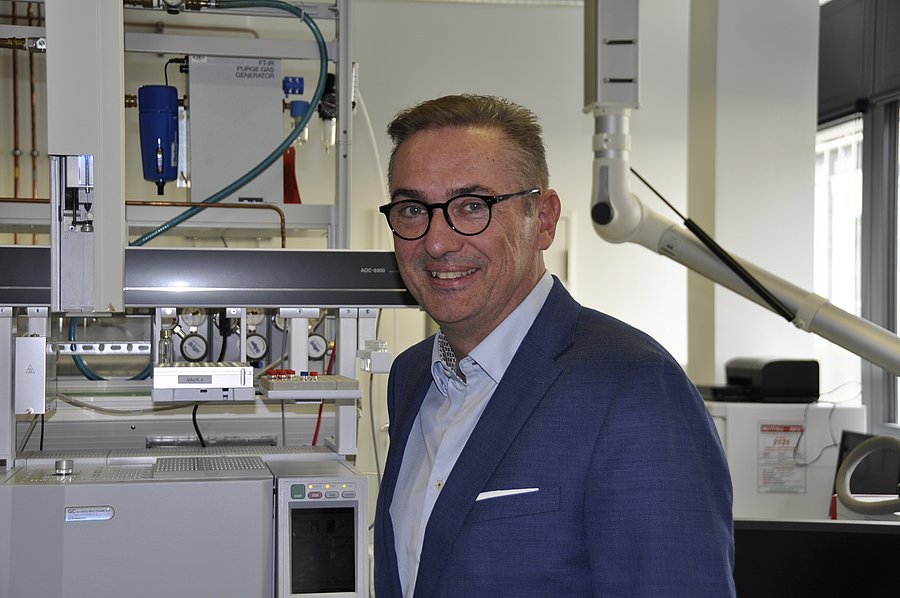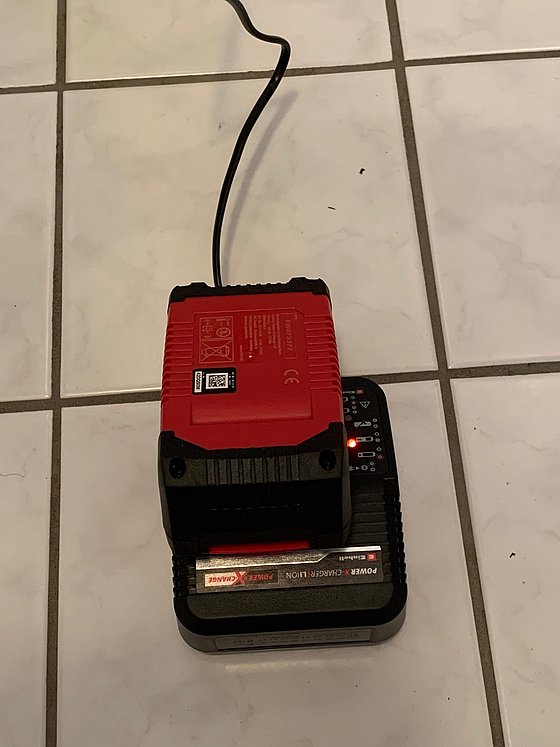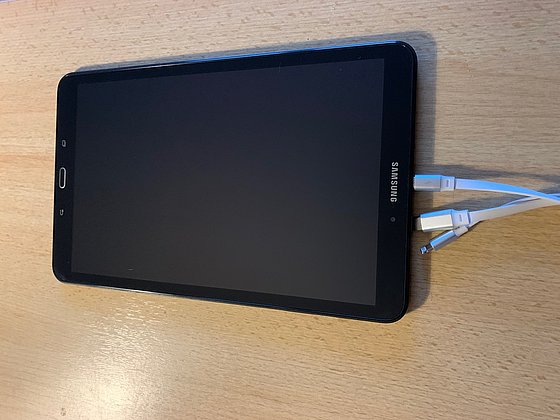
Safe handling of lithium batteries
Prof. Dr. Roland Goertz / Safety engineering
Photo: UniService Transfer
"Batteries should only ever be charged when you are awake and alert".
Prof. Dr. Roland Goertz from the Chair of Chemical Safety and Fire Defense on the safe handling of rechargeable lithium batteries and professional help in the event of a fire.
Lithium batteries are found in multiple quantities in our households today. Whether cell phones, computers, aquarium accessories, alarm systems, answering machines, wristwatches, baby monitors or ovens, the list is endless. In practice, it has been shown that fires involving lithium-ion batteries are difficult to extinguish. Prof. Dr. Roland Goertz heads the Chair of Chemical Safety and Defensive Fire Protection at Bergische Universität and has been studying this phenomenon for years. "Lithium batteries can be handled well and safely," says the accomplished scientist. Thanks to his many years of experience as the head of two professional fire departments, he knows the most diverse fire hazards very well, leads various projects on this at the university, gives lectures internationally and is consulted as a valued expert in current fire disaster situations.
Lithium in primary and secondary batteries
"The word lithium comes from the Greek lithos, meaning the stone," Goertz explains up front. "It is the third smallest element in the periodic table and in the universe. In the evolutionary history of the elements of the universe, it's one of the oldest elements we have." Because it is also the lightest metal of all, we find it in many batteries today. But the chemical element is found in both primary and secondary lithium batteries, and that's important to know because primary batteries can't be recharged. "Due to anglicization -in English there is only the term 'battery`- today people say battery in all cases, but in the case of lithium-ion batteries they mean accumulators. The primary lithium batteries are then the metal batteries. They are not rechargeable, hang e.g. in heat meters on the ei
heater or in other places. There is metallic lithium in them that reacts over time and then provides the voltage," says the expert. Rechargeable secondary batteries are a different story. "The rechargeable lithium ion batteries basically don't contain any metallic lithium at all. There, the lithium always shifts back and forth through a separator during charging and discharging, forming mostly graphitized lithium at the anode." Rechargeable batteries are therefore the main focus of the chair's attention, because in the course of digitalization, fire hazards are increasing in this area and it is necessary to familiarize fire departments and users with plausible measures for possible firefighting.

Always charge batteries where there is no combustible material
Photo: UniService Transfer
Despite all the prophecies of doom: Water is still the best
Since 2007, Goertz has already been involved in preventive fire protection during fire incidents with lithium-ion batteries and says: "You always need water! This overly cautious not to treat metallic lithium with water is still stuck in people's heads, but it ends up that with rechargeable batteries, water is best." However, to avoid ignition in the first place, every user* of rechargeable batteries can usually already take preventive measures. "Lithium-ion batteries, or generally such devices that need to be charged, should only ever be charged when you are awake and alert, preferably not overnight," explains Goertz, emphasizing that with billions of charging and discharging processes worldwide within 24 hours, little actually happens. The important thing, the chemist explains, is to do it whenever you can keep an eye on it and only charge where, if something were to happen, there would be as little damage as possible. "Let's take a pedelec battery. That shouldn't be charged on a pillow or other insulating material because there's always the possibility of a fire if heat is emitted. You then do that in the garage or on the balcony. And if that's not possible, somewhere where there's no flammable material and, above all, always when you're not sleeping."
In search of suitable extinguishing agents
Water is still the best extinguishing agent, Goertz explains. "You can certainly add some additives to water, surfactants, to make it penetrate better, so that the surface tension is reduced. I've also done experiments where calcium salts have been added to the water so that the hydrofluoric acid released during battery decomposition is better bound," he continues, adding that foams are also used, although their use, often with ecotoxic effects, is the subject of intense debate in the course of environmental protection. "That's where we're also working on a research project for the German Federal Environmental Agency, where it's about replacing these foams."
First aid in your own four walls: Fire extinguisher spray cans
"The lithium-ion batteries in households are a source of ignition and can be the cause of fires," the scientist explains, and generally recommends a fire extinguisher spray can for one's own home. "The fire extinguisher is actually too big for home use and also too expensive for some people," Goertz explains. In addition, an extinguisher is associated with regular maintenance. Such a spray can could be used for three to five years. For the Advent wreath fire, it is perfectly adequate and also works for lithium batteries. "You can't really extinguish them, but it's always a matter of, if several cells are installed in a module and one cell goes through, that you then prevent or reduce the spread and use it as a suffocation effect," he explains. "If the complete battery really goes through, then it goes so fast, you can't stop that at all, because there we quickly have temperatures of 1,000 degrees."
Fire departments are well prepared for hazardous situations
Roland Goertz is also director of the Fire Science Institute (FSI) at Bergische Universität, a center of excellence for research into the scientific, technical and organizational aspects of firefighting and non-police hazard prevention. The demand planning of German professional fire departments is good and has developed positively over the years, he says. "We are, after all, always active with the fire departments in the scientific monitoring of their demand planning and have already done projects with larger and smaller fire departments in which we used statistical methods to look at how the fire departments can set themselves up so that they are on site in the right strength in good time." He and his team have developed these statistical methods in an additional project entitled 'Safety and efficiency in demand planning', funded by the Stiftung Zukunft NRW foundation. For the volunteer fire departments, the starting situation is different, because the active firefighters do not necessarily work at their place of residence. Here, suitable solutions are still being sought to optimize the so-called 'daily alarm availability'.
International expertise in the event of damage
The Freemantle Highway fire off Ameland in July put the world on alert. Possibly caused by a lithium battery in an e-car that had ignited, a ship carrying nearly 4,000 loaded passenger cars burned. Goertz has also become an international focal point in this field, as he is also involved in fire cause investigation in another area of research. The firefighting work off Ameland was difficult. The Wuppertal safety engineer was called in to investigate the cause of the fire. "I have now been on this large car carrier ship, the Freemantle Highway, three times," he explains, but cannot provide any further information due to the ongoing investigation. However, the general situation of a fire on the open sea is always difficult, he says, because the crew of a large freighter consists of only a handful of people, some of whom also have firefighting training. "But at 00:00 at night in the dark North Sea, it's anything but great. That raises a lot of questions that I also talked about last year at a lecture in Chicago, namely whether you don't have to protect such transports technically in a different way." It's not so much about defense, he said, because on a car carrier ship you don't have any space at all, the cars are packed in there and no one can get through with firefighting equipment. "Even on a container ship, if one of the containers starts burning down there in a cargo hatch, you can't get to it. So it's more of a question of whether the extinguishing equipment that's installed is also working properly and having an impact on the fire?"
Emergency response management for accidents involving electric vehicles
Goertz is a proponent of uniform, nationwide procedural measures in the event of a fire and has already held a workshop in Wuppertal with a working group, led by the Berlin Fire Department, which is proposing some kind of uniform procedure for all 16 German states in the event of accidents involving electric vehicles. Goertz explains the difference in the procedure in the event of a fire in a normal car accident compared to an e-car accident as follows: "You come onto the highway, someone is trapped in the car and is seriously injured in his car. You then try to get the person out of there. In the past, they would then look to see if fuel was leaking and if there was a risk of explosion. Now, if the electric car is not doing anything yet, it is calm and peaceful at first, but because of the mechanical impact on the battery, the battery is possibly in a critical state and can go thermal at any moment. Then the question is, how can you save the person now, even though toxic and flammable gases can suddenly escape from the battery in large quantities at any moment?" Goertz has also already conducted a research project for the ADAC on human rescue from electric vehicles. He repeatedly discusses the issue with fire departments and plays out scenarios in order to arrive at plausible measures.

Tablet in charging mode
Photo: UniService Transfer
Rechargeable batteries do not belong in the normal trash can
Disposing of all these rechargeable devices poses another safety risk, because the parts don't belong in the trash can. "They have to go into the appropriate collection bins, of course," says Goertz. "In the SUVEREN2USE research project, we are dealing with the entire value chain of lithium-ion batteries, i.e., from production to use, storage to disposal and also to damage." The list of cooperation partners is equally broad, consisting of disposal companies and extinguishing system manufacturers, among others. And his team is also looking at a reuse of e-car batteries that are no longer functional. "We have done a project with the German Federal Environmental Foundation (DBU) on the topic of 'reuse of lithium-ion batteries`. If those in electric vehicles perform at less than 80% of capacity, they are actually no longer good to use for vehicles, but can still be used well in a stationary operation."
Fire incidents occur frequently, especially when lithium batteries are disposed of incorrectly. "After all, I also do fire investigation and have had cases in such waste sorting facilities. These are the so-called misthrows, that is, when people unfortunately foolishly dispose of any lithium batteries, devices with batteries or those "annoying" greeting cards that sound a melody when opened, in the normal trash can. Then there's a battery that gets shredded at the waste sorting facilities and starts to burn. These misthrows are a very big problem." Hence his plea to all users*, "Batteries should always be dropped off at stores that have collection boxes. This is the normal and safe way, and it usually works well."
Uwe Blass
Prof. Dr. Roland Goertz has been head of the Department of Chemical Safety and Fire Protection in the Faculty of Mechanical Engineering and Safety Engineering at Bergische Universität since 2012.
